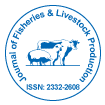Nuestro grupo organiza más de 3000 Series de conferencias Eventos cada año en EE. UU., Europa y América. Asia con el apoyo de 1.000 sociedades científicas más y publica más de 700 Acceso abierto Revistas que contienen más de 50.000 personalidades eminentes, científicos de renombre como miembros del consejo editorial.
Revistas de acceso abierto que ganan más lectores y citas
700 revistas y 15 000 000 de lectores Cada revista obtiene más de 25 000 lectores
Indexado en
- Índice Copérnico
- Google Académico
- sherpa romeo
- Abrir puerta J
- Claves Académicas
- Biblioteca de revistas electrónicas
- Búsqueda de referencia
- Directorio de indexación de revistas de investigación (DRJI)
- Universidad Hamdard
- EBSCO AZ
- OCLC-WorldCat
- director académico
- Catálogo en línea SWB
- Biblioteca Virtual de Biología (vifabio)
- publones
- Pub Europeo
- Universidad de Cardiff
Enlaces útiles
Revistas de acceso abierto
Comparte esta página
Abstracto
Effect of Maize Silage on Feedlot Performance, Carcass Traits and Meat Quality of Ethiopian Cattle
Ayano Abera Gage, Yesihak Yusuf Mummed, Ewonetu Kebede, Meseret Girma
The experiment was conducted at Haramaya University Beef fattening station, to evaluate the effect of maize silage inclusion at different levels on feed intake, growth performance, carcass characteristics, and meat quality. Sixteen castrated Harar oxen of average age 6 years with the initial body weight of 229±1.18 kg (mean + SE) were used for the experiment. The animals were randomly distributed to four treatments each with four replications in a completely randomized design and the trial lasted for 90 days. The dietary treatments contained the native hay as basal diet and maize silage inclusion at a proportion of 0, 33, 67, and 100% for T1, T2, T3, and T4, respectively. The animals were watered and supplemented with a concentrate ration at 1.25% of their body weight twice a day. Daily dry matter intake of the ox was significantly higher (P<0.01) for T4 (8.05kg/day). Higher (P<0.001) total nutrients intake other than acid detergent fiber (ADF) and ash were recorded in the T4. The daily body gain was higher (P<0.01) for T1 (1.09 kg) than all. The dressing percentage on a slaughter basis was higher (P<0.001) for T1 (55.40%) than other treatments. The quality of beef based on Warner-Bratzler Shear Force test results, T1 and T4, T2, and T3 were categorized as tough, tender, and intermediate, respectively. Water holding capacity was significantly good (P<0.05) for T2 and T3 as compared to T1 and T4, however, no change in the pHu. Therefore, it could be concluded that the inclusion of maize silage up to 33% could be confirmed for better performance, feed conversion efficiency, carcass and meat quality parameters in the feeding of fattening oxen.
Revistas por tema
- Agricultura y acuicultura
- Alimentación y Nutrición
- Bioinformática y biología de sistemas
- Bioquímica
- Ciencia de los Materiales
- Ciencia general
- Ciencias Ambientales
- Ciencias Clínicas
- Ciencias farmacéuticas
- Ciencias Médicas
- Ciencias Sociales y Políticas
- Ciencias Veterinarias
- Enfermería y atención sanitaria
- Física
- Genética y biología molecular
- Geología y Ciencias de la Tierra
- Ingeniería
- Inmunología y Microbiología
- Química
Revistas clínicas y médicas
- Anestesiología
- Biología Molecular
- Cardiología
- Cirugía
- Cuidado de la salud
- Dermatología
- Diabetes y Endocrinología
- Enfermedades infecciosas
- Enfermería
- Gastroenterología
- Genética
- Inmunología
- Investigación clínica
- Medicamento
- Microbiología
- Neurología
- Odontología
- Oftalmología
- Oncología
- Pediatría
- Toxicología

 English
English  Chinese
Chinese  Russian
Russian  German
German  French
French  Japanese
Japanese  Portuguese
Portuguese  Hindi
Hindi